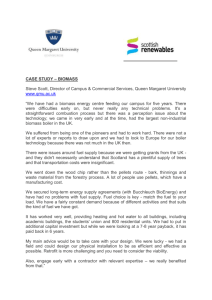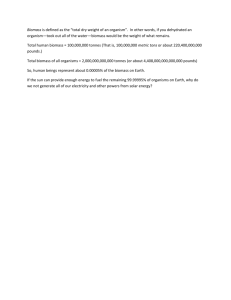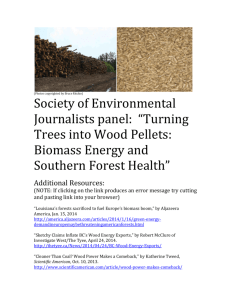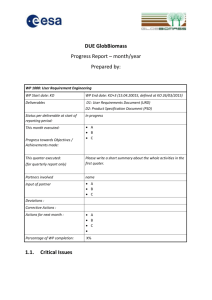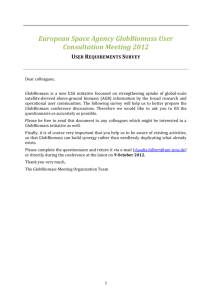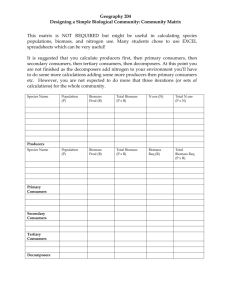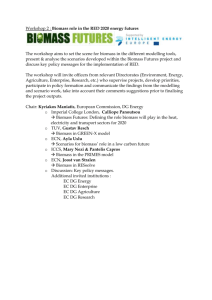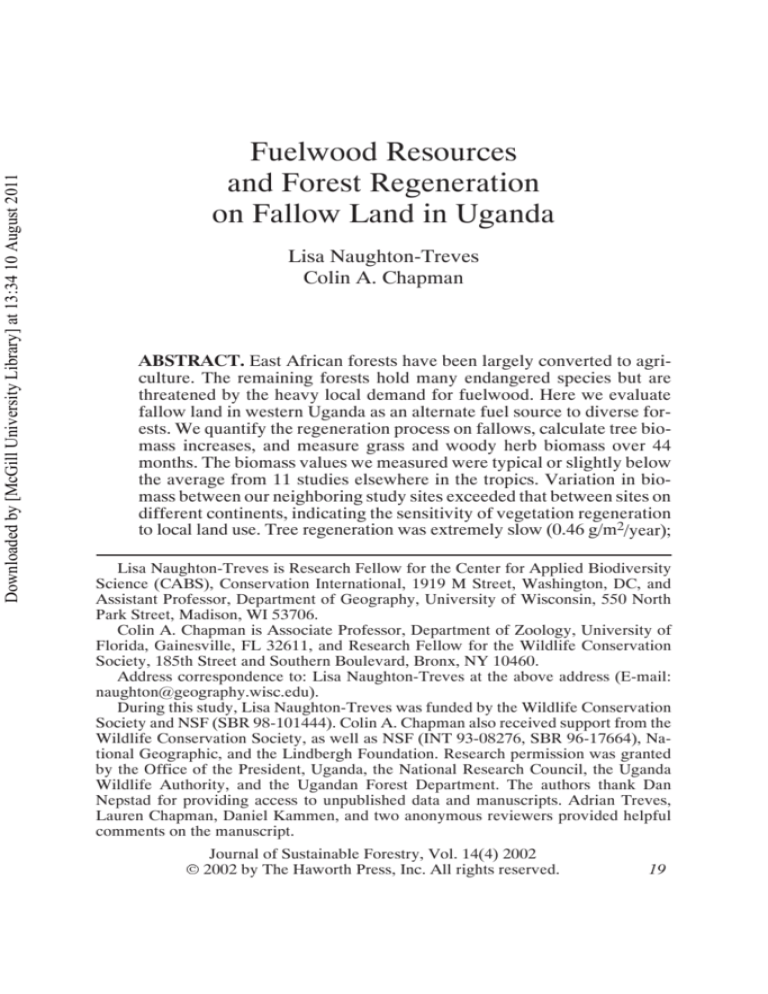
Downloaded by [McGill University Library] at 13:34 10 August 2011
Fuelwood Resources
and Forest Regeneration
on Fallow Land in Uganda
Lisa Naughton-Treves
Colin A. Chapman
ABSTRACT. East African forests have been largely converted to agriculture. The remaining forests hold many endangered species but are
threatened by the heavy local demand for fuelwood. Here we evaluate
fallow land in western Uganda as an alternate fuel source to diverse forests. We quantify the regeneration process on fallows, calculate tree biomass increases, and measure grass and woody herb biomass over 44
months. The biomass values we measured were typical or slightly below
the average from 11 studies elsewhere in the tropics. Variation in biomass between our neighboring study sites exceeded that between sites on
different continents, indicating the sensitivity of vegetation regeneration
to local land use. Tree regeneration was extremely slow (0.46 g/m2/year);
Lisa Naughton-Treves is Research Fellow for the Center for Applied Biodiversity
Science (CABS), Conservation International, 1919 M Street, Washington, DC, and
Assistant Professor, Department of Geography, University of Wisconsin, 550 North
Park Street, Madison, WI 53706.
Colin A. Chapman is Associate Professor, Department of Zoology, University of
Florida, Gainesville, FL 32611, and Research Fellow for the Wildlife Conservation
Society, 185th Street and Southern Boulevard, Bronx, NY 10460.
Address correspondence to: Lisa Naughton-Treves at the above address (E-mail:
naughton@geography.wisc.edu).
During this study, Lisa Naughton-Treves was funded by the Wildlife Conservation
Society and NSF (SBR 98-101444). Colin A. Chapman also received support from the
Wildlife Conservation Society, as well as NSF (INT 93-08276, SBR 96-17664), National Geographic, and the Lindbergh Foundation. Research permission was granted
by the Office of the President, Uganda, the National Research Council, the Uganda
Wildlife Authority, and the Ugandan Forest Department. The authors thank Dan
Nepstad for providing access to unpublished data and manuscripts. Adrian Treves,
Lauren Chapman, Daniel Kammen, and two anonymous reviewers provided helpful
comments on the manuscript.
Journal of Sustainable Forestry, Vol. 14(4) 2002
Ó 2002 by The Haworth Press, Inc. All rights reserved.
19
Downloaded by [McGill University Library] at 13:34 10 August 2011
20
JOURNAL OF SUSTAINABLE FORESTRY
however, the woody herbs and grasses on a 4 year old fallow of ~0.5 ha
can provide much of a family’s domestic fuel. Fallow land is generally
abundant in western Uganda and can partially alleviate pressure on forests
for domestic fuels. Fallows cannot however provide the trees demanded
by charcoal, brick, and gin manufacturers. In the future, conserving forests while meeting fuelwood demands will require improving local land
tenure security, enhancing the productivity of cultivated and abandoned
land, promoting more efficient stoves, stills and kilns, and curtailing illicit, inefficient charcoal manufacture. [Article copies available for a fee
from The Haworth Document Delivery Service: 1-800-342-9678. E-mail address: <getinfo@haworthpressinc.com> Website: <http://www.HaworthPress.
com> Ó 2002 by The Haworth Press, Inc. All rights reserved.]
KEYWORDS. Biomass fuels, east Africa, fuelwood, fallow, grassland,
Kibale National Park, regeneration, succession, Uganda
INTRODUCTION
People have modified east African forests for at least 2,000 years
(Hamilton, 1981). Their land use partly created the present spatial heterogeneity of the region’s vegetation (Chapman and Chapman, 1996).
However, the intensity of contemporary forest use and rate of conversion to agricultural land is unprecedented (FAO, 1999; Lanly et al.,
1991; Struhsaker, 1997). Today less than 70,000 km2 (28%) remains of
East Africa’s original forests (Martin, 1991).1 These forests, like most
in Africa, are steadily being converted to farmland. Yet during recent
years, the net gain in cropland across Africa was considerably less than
the net reduction in forests (FAO, 1993; Houghton, 1994). The discrepancy is explained in part by the significant expansion of abandoned and
degraded agricultural lands. Every year large areas of forest are converted to cropland, but an even more extensive area of pastures and
croplands are left fallow or abandoned (Houghton, 1994). Blaming
small scale agriculturalists for deforestation in Africa is inappropriate,
considering the fact that forest clearing, land abandonment, and reclamation operate at different temporal and spatial scales, and are often
driven by regional or international markets for charcoal or timber
(O’Keefe et al., 1984). Nonetheless, abandoned and degraded lands are
rapidly expanding, and account for 88% of the net loss of forests in tropical Africa, a level far greater than tropical Asia or America (59% and
34%, respectively) (Houghton, 1994).
Downloaded by [McGill University Library] at 13:34 10 August 2011
Lisa Naughton-Treves and Colin A. Chapman
21
Conservationists rarely consider the value of fallow or abandoned
agricultural land for slowing deforestation. This oversight ignores the
fact that fallow land can potentially provide vital resources to local people (biomass fuels in particular) and thus alleviate pressure on remaining high canopy forests. The conservation importance of bush fallow
(Norman, 1979) is underscored by the fact that to date, forested African
countries have set aside less than 4% of their territory as National Parks
or similar protected areas (Chapman et al., 1999; World Resources Institute, 1996). The majority of tropical forests lie outside of parks and
have experienced or will soon experience major anthropogenic pressure.
The primary resource extracted from abandoned or fallow agricultural land in east Africa is fuelwood (Barnes et al., 1984; Edmunds,
1997; Wallmo and Jacobson, 1998). Escalating fuelwood demands and
forest degradation are commonly reported in arid and semi-arid tropical
regions (Leach and Mearns, 1988; Vermeulen et al., 1996). Fuelwood
use also has great economic and ecological importance in the humid
tropics. For example, during the early 1980s, 90-95% of the total wood
consumed in Uganda was used for fuel (Hamilton, 1984). Today wood
and charcoal supply > 95% of rural energy requirements in the humid
region of western Uganda, one of the highest levels in the world
(Bradley, 1991; Government of Uganda, 1992). Current harvest rates
are generally considered unsustainable (Howard, 1991). The increased
demands for fuelwood and international concern over forest loss have
inspired a myriad of programs to reforest land or use fuelwood more efficiently (Howard, 1991; Wallmo and Jacobson, 1998). However, reforestation efforts alone cannot meet the increasing demand for fuelwood
(Struhsaker, 1987), and providing fuel-efficient technology may not significantly reduce consumption rates (Wallmo and Jacobson, 1998).
These conditions call for detailed studies of biomass fuel sources other
than plantations and natural forests.
Using 44 months of field data on biomass accumulation, we evaluate
fallow agricultural land in western Uganda as a source of fuel. We provide a detailed quantification of the regeneration process following
abandonment, calculate the annual increment of tree biomass, and measure the biomass of woody grasses and herbs after 44 months of regeneration. We then compare our results to other studies in the tropics,
which describe biomass accumulations after different types of human
modifications. Finally, we evaluate the capacity of fallow land to meet
the growing fuelwood demands of both commercial and domestic consumers.
22
JOURNAL OF SUSTAINABLE FORESTRY
Downloaded by [McGill University Library] at 13:34 10 August 2011
MATERIALS AND METHODS
Study Site and Local Land Use
The study was conducted within Kibale National Park, Uganda (Figure 1). Kibale (766 km2) is found just east of the Ruwenzori Mountains
(0° 13⬘-0 41⬘ N and 30° 19⬘-30 32⬘ E), at an elevation of 1500 m and receives 1700 mm rainfall per year (1984-1996). Around Kibale, people
use land primarily for semi-intensive rainfed cropping (54% of the area,
Naughton-Treves, 1998). Farms near Kibale average 1.4 ha, of which
on average 40% is under fallow (Naughton-Treves, 1998). Fallows vary
considerably in age, from a single season to > 20 years. Classifying fallow vegetation is difficult due to the innumerable possible sequences in
land use (grazing, slashing, burning, interplanting, etc.), which lead to
variable patterns of succession. For the purposes of this study, we define “abandoned” land as arable land free of cultivation or grazing for
over four years. This definition encompasses vegetation under a variety
of socioeconomic and tenurial categories. Rarely is land in western
Uganda “abandoned” in the sociopolitical sense, rather, most bushy
fallows are claimed and/or valued by local user groups, women in particular (Croll and Parkin, 1992; Edmunds, 1997).
Treatment of Regeneration Plots
At our first study site (Site 1), we measured annual fuelwood accumulation for 44 months after cultivation was abandoned. At Site 2 we
made a single assessment of fuelwood biomass on land fallowed for 6
years after several years of grazing and cultivation. These two sites
were within the park, were separated by 200 m, and lay adjacent to
300-ha of natural forest.
Site 1 was located within the National Park where corn (Zea mays)
and yams (Dioscorea sp.) had been cultivated for three consecutive
years, then abandoned. As per local farming tradition, most trees, logs,
and stumps had been removed, the area burnt, and the soil hoed by hand.
Each year, before planting, the area was burnt and hoed to remove colonizing grasses (e.g., Pennesetum purpureum). Two seasonal plantings
were made during each year of cultivation. The land was subsequently
abandoned in 1987. At the onset of the study in August 1993, the land
was again hoed by hand as if it were to be planted, but was then abandoned. A 30 m by 50 m plot was selected and subdivided into 10 m by
10 m subplots (n = 15). The location, size, and identity of any trees in
Lisa Naughton-Treves and Colin A. Chapman
23
Downloaded by [McGill University Library] at 13:34 10 August 2011
FIGURE 1. Map of study site, Kibale National Park, Uganda.
Study Site
0
5 km
N
Kibale
National
Park,
Uganda
SUDAN
UGANDA
D.R. of
CONGO
Lake
Albert
Lake
Kyoga
Kibale
National
Park
KENYA
Lake
Victoria
RWANDA TANZANIA
the plot were recorded. Fire was suppressed and no extraction occurred
during the entire study period.
Site 2 (7097 m2) had a longer and more intense history of use. This
area is also within the park’s boundaries, but it had been cleared prior to
1970 for grazing. Thereafter, vegetation was cut and burned repeatedly
so as to maintain a pasture for over two decades. Bananas were once
planted in the area, but soon abandoned. At times the area was also used
as a soccer field (T.T. Struhsaker, pers. comm.), but it was primarily
used for grazing. In 1991 the area was abandoned and no longer cut or
Downloaded by [McGill University Library] at 13:34 10 August 2011
24
JOURNAL OF SUSTAINABLE FORESTRY
burned. In June of 1997, the vegetation growing at this site was assessed.
The fuel sources present at Sites 1 and 2 included: trees, elephant
grass (Pennesetum purpureum), and a fast growing woody herb, Acanthus pubescens. Each source was evaluated separately. The establishment, growth, and mortality of natural tree seedlings were monitored at
Site 1 approximately every 3 months for 44 months (September 1993 to
April 1997). Each 10 m by 10 m subplot (n = 15) was searched for seedlings and every tree seedling encountered was identified by species and
marked. Local residents generally only harvest trees > 50 cm height, using small saplings as kindling and larger poles for cooking. Accordingly, only trees > 50 cm were included in fuelwood biomass calculations.
To estimate annual above-ground living tree biomass, regression equations were calculated between tree height and dry weight for a sample of
similar trees harvested from forest patches outside of the park (n = 28,
trees > 50 cm to 2 m in height, no tree had exceeded 2 m by the end of
the study; methods follow Whittaker and Marks, 1975 and Uhl, 1987).
The species selected from forest patches were those commonly found in
the study plots, and approximated the relative abundance of the species
in the study area. For each tree, its height and diameter at ground level
were measured after the tree was harvested by cutting it at ground level.
Then leaves were separated from stems and trunk and all components
were returned to our field camp where wet weight was determined. The
material considered locally as fuel (stems and trunk) were then air dried
by hanging them under a tin roof that protected them from the rain, but
permitted airflow. Samples were allowed to dry until they reached a
constant weight. Regression equations between tree height and dry
weight were established from this sample (Log dry weight = 0.00452
(height) + 1.476; r2 = 0.791, P < 0.0001, n = 28). Subsequently, the expected dry weight of every tree > 50 cm tall was calculated for the Site 1
plot.
We measured vegetation changes in Site 1 every 3 months. Four
quadrats (65 cm ⫻ 65 cm) were placed in each of the 25 subplots, 2 m
from the center of the subplot at each cardinal point. This sampling revealed that, unlike other studies conducted in South America, grasses
(particularly elephant grass–Pennesetum purpureum) and the woody
herb, Acanthus pubescens, constituted a significant component of the
biomass. Thus, in the final sampling period (April 1997), the height of
all A. pubescens stems were measured (n = 161, density = 1.07 stems/m2)
and dry weight was estimated for all stems in the plot using regression
equations for height to dry weight derived from forest patches outside
Downloaded by [McGill University Library] at 13:34 10 August 2011
Lisa Naughton-Treves and Colin A. Chapman
25
of the National Park (dry weight = 0.7165(height) ⫺ 885.243; r2 =
0.584, P < 0.004, n = 12).
Elephant grass grows in dense clusters over extensive areas and typically reaches a height of 2 m. The proportion of each 10 m by 10 m subplot dominated by elephant grass was visually estimated. At the end of
the study, twelve 1 m2 areas (locations randomly selected) were harvested by cutting all stems at ground level. These grass bundles were
transported back to camp and weighed. Subsequently, local residents
were asked to separate those components of the grass that they would
use as a fuel source from those they would discard. The fuel component
of the grass they identified was then dried.
In the second area (Site 2), all A. pubescens stems were measured and
the proportion of the area under elephant grass was measured in June
1997 (roughly 6 years after this heavily modified area was abandoned).
No attempt was made to locate tree seedlings because (a) the A.
pubescens and elephant grasses were often very difficult to penetrate,
and (b) the detailed study of Site 1 suggested that trees rarely grew high
and thus were contributing little to the overall biomass of the area. The
biomass of usable A. pubescens and elephant grass was determined as in
Site 1.
Comparing Regeneration Rates with Other Tropical Sites
To assess the generality of patterns observed at Kibale, we reviewed
similar studies conducted elsewhere in the humid tropics. Here we only
report results from those studies that approximate the four year period
used in this study. Long-term regeneration records (e.g., the 60-80 year
period reported by Saldarriaga et al., 1988) provide critical benchmark
data, but far exceed the practical constraints and planning horizon of individuals managing fallows around Kibale. Caution should be used
when comparing the results of these studies to ours because they all report total biomass, not the amount of biomass suitable for local fuel use.
In our study, local residents identified only 62% of the total biomass as
a potential fuel source. Therefore in addition to reporting data from
other studies on total biomass, we use a conversion factor of 62% to estimate fuel biomass accumulated at each site. By so doing, we assume
that elsewhere a similar proportion of the total biomass is available for
fuel as what we documented at our Ugandan site. This assumption is
likely violated in locations where biomass is accumulated in plants that
are unsuitable for burning (e.g., short grasses; Richards, 1996; Uhl,
1987).
26
JOURNAL OF SUSTAINABLE FORESTRY
Downloaded by [McGill University Library] at 13:34 10 August 2011
RESULTS
The rate of tree seedling establishment was slow during the first 2
years following abandonment, but increased rapidly during years 3 and
4 (Figure 2a). Mortality of seedlings followed a similar pattern (Figure 2b).
After 44 months, only 3 trees had reached > 1 m in height (Acrocapus
fraxinifolius, Persea americana-Avocado, and Maesa lanceolata) and
only 20 trees exceeded 50 cm. No tree at Site 1 exceeded 2 m by the end
of the study. A. fraxinifolius was introduced to East Africa from Southeast Asia and is planted as a source of fuelwood. Avocado is an exotic
introduced for its edible fruits. The seed was likely introduced when the
area was cleared. M. lanceolata is a fast growing native tree that coppices readily. Tree biomass was extremely low throughout the study. It
increased steadily over the first three years (year 1 = 0.64 g/m2, year 2 =
1.01 g/m2, year 3 = 1.07 g/m2), but declined in the fourth year (⫺0.89
g/m2). The decline followed increased mortality of trees between 50 cm
to 1 m tall and slow recruitment into this size class. This increased mortality corresponded to the time when elephant grass dominated the plot
and A. pubescens was increasingly common (Figure 2c). In general,
trees made up a very small component of the potential fuel sources that
grew on the plot in the 44 months following abandonment.
Vegetative cover at the Site 1 plot was assessed 11 times between
November 1993 and April 1997 (41 months) at approximately 3 month
intervals. Short grasses and non-woody herbs dominated the first year
of growth (particularly Cynodon dactylon and Bidens pilosa). Elephant
grass soon succeeded short grass and gradually dominated the area
(Figure 2c). Near the end of the study, A. pubescens began replacing elephant grass (Figure 2c). By year 4, the biomass of elephant grass fuel
averaged 1492 g/m2, while A. pubescens fuel biomass averaged 1810
g/m2. At the second site, the biomass of elephant grass after 6 years was
1684 g/m2, while A. pubescens biomass was 172 g/m2. Total biomass
accumulated at Sites 1 and 2 was 5,361 and 2,994 g/m2, respectively.
We located data on above-ground dry biomass for 25 sites, from 11
studies (Table 1). The biomass ranged from 77 g/m2 on a Venezuelan
site which had been cut and cleared by a bulldozer and then abandoned
for 3 years, to 8890 g/m2 on an 8 year old abandoned pasture in Brazil.
This variation is not surprising considering the diversity of land use
practices and physical conditions. The biomass values we measured at
Kibale appear to be typical or slightly lower than the average from the
11 studies.
27
FIGURE 2. Description of the restoration process that occurred on a section
(30 m by 50 m) of fallow agricultural land that was converted from moist-tropical
forest in Kibale National Park, Uganda: (a) the number of seedlings found in the
restoration plot, (b) % of seedlings dying between sampling periods, (c) the %
of quadrats dominated by Pennesetum purpureum (elephant grass) and Acanthus pubescens.
# of Seedlings
800
600
400
200
0
Aug. 93 Mar. 94
Sep. 94
Apr. 95
Oct. 95
% Seedling Mortality
15
May 96
Dec. 96 Jun. 97
All Seedlings
10
Seedlings
> 50 cm
5
0
Aug. 93 Mar. 94
Sep. 94
Apr. 95
Oct. 95
80
Vegetative
Dominance
Downloaded by [McGill University Library] at 13:34 10 August 2011
Lisa Naughton-Treves and Colin A. Chapman
May 96
Dec. 96 Jun. 97
Pennesetum
60
40
20
Acanthus
0
Aug. 93
Mar. 94
Sep. 94
Apr. 95
Oct. 95
May 96
Dec. 96
Jun. 97
MANAGEMENT IMPLICATIONS
Substantial biomass fuel was found on Ugandan agricultural land
that had been abandoned for 4-6 years. The majority of this biomass
was elephant grass and a woody herb (A. pubescens). Tree regeneration
was slow and did not contribute a substantial proportion to the biomass.
28
JOURNAL OF SUSTAINABLE FORESTRY
Downloaded by [McGill University Library] at 13:34 10 August 2011
TABLE 1. Standing dry vegetation biomass (g/m2) at Kibale National Park,
Uganda and 25 other tropical sites following different periods since abandonment and different types of land use practices.
Years
4
6
9
4
4
4
4
5
6
3
3
3
4
3.5
4.5
8
8
3.5
3.5
4
7.5
8
2.5
2.5
8
Land Use
Slash and Burn
Pasture, Heavy Use
Slash and Burn
Mixed Species Fallow
Slash and Burn
Slash and Burn
Slash and Burn
Slash and Burn
Slash and Burn
Cut Forest
Cut and Burned
Cut and Bulldozed
Slash and Burn
Pasture, Light Use
Pasture, Light Use
Pasture, Light Use
Pasture, Light Use
Pasture, Moderate Use
Pasture, Moderate Use
Pasture, Moderate Use
Pasture, Moderate Use
Pasture, Moderate Use
Pasture, Heavy Use
Pasture, Heavy Use
Pasture, Heavy Use
Dry Biomass
5361
2994
5130
2771
2888
3796
4839
7669
4609
1291
870
77
2861
2940
5340
8610
8890
830
1680
1700
3700
3280
760
1550
470
Fuel
3308
1856
3181
1718
1791
2354
3000
4755
2858
800
539
48
1774
1823
3311
5338
5512
515
1041
1054
2294
2034
456
961
291
Source/Site
This Study, Uganda
This Study, Uganda
Saldarriaga et al. 1988, Columbia/Venezuela
Tergas 1965, Guatemala
Uhl and Jordon 1984, Venezuela
Ewel 1971, Panama
Gamble et al. 1969 (in 1), Colombia
Bartholomew et al. 1953, DR Congo
Nye & Greenland 1960 (in 1), Nigeria
Uhl et al. 1982, Venezuela
Uhl et al. 1982, Venezuela
Uhl et al. 1982, Venezuela
Uhl 1987, Venezuela
Buschbacher et al. 1992, Brazil
Buschbacher et al. 1992, Brazil
Buschbacher et al. 1992, Brazil
Buschbacher et al. 1992, Brazil
Buschbacher et al. 1992, Brazil
Buschbacher et al. 1992, Brazil
Buschbacher et al. 1992, Brazil
Buschbacher et al. 1992, Brazil
Buschbacher et al. 1992, Brazil
Buschbacher et al. 1992, Brazil
Buschbacher et al. 1992, Brazil
Buschbacher et al. 1992, Brazil
1 = Uhl and Jordon 1984
Note: For the 11 other sites we estimate the amount of the total biomass that could be used as a fuel source assuming a similar ratio of total biomass to fuel biomass as was calculated in this study (62%). The relationship between
above-ground dry biomass and the year since abandonment for 25 sites (biomass = 664.54 (year)-12.531, r =
0.552, P = 0.004). Years = Years since abandonment, Dry Biomass and Fuel is expressed as g/m2.
Only a very small proportion of the biomass was exotic species (e.g.,
Lantana sp.). People readily use both elephant grass and A. pubescens
for cooking, particularly for small meals or warming foods. These two
plants are not suitable for tasks which require high heats or long cooking times (e.g., cooking beans), nor for commercial uses (e.g., firing
bricks in kilns or distilling banana gin; Vermeuln et al., 1996).
Estimates of domestic fuel use by people around Kibale indicate that
a typical family (5.1 people) uses 8.4 kg of fuelwood each day for cooking (Wallmo, 1996). Thus, in one year a local family would use 3,066
kg, and in 4 years, 12,264 kg (this value is slightly lower than average
for non-Liquid Propane Gas users in East Africa, Kammen, 1995). In
our 4 year study, the amount of cooking fuel accumulating at Site 1 was
3.3 kg/m2. Given these values, an average family would require an area
of 3,716 m2 (0.37 ha) to meet many of their domestic fuel needs; an area
Downloaded by [McGill University Library] at 13:34 10 August 2011
Lisa Naughton-Treves and Colin A. Chapman
29
less than the average farm fallow size near Kibale (0.55 ha). A similar
set of calculations from Site 2 indicates that a family would need to
leave an area of 6,813 m2 (0.68 ha) fallow to meet their fuel needs, a
value exceeding the average fallow size. The variability between Site 1
and 2 reflects the great sensitivity of vegetative regeneration to local
land use. The data from these sites also suggest that many farmers are
able to rely heavily on private fallows for domestic fuel supply, however, those residing on degraded or small farms cannot.
The regression equation derived from the data in Table 1 allows us to
predict biomass regeneration over 4 years in a variety of tropical countries after various types of human modification. Based on this equation,
4 years after abandonment, tropical lands at 25 sites on average accumulated 2.6 kg/m2. If, as in Kibale, 62% of this biomass is suitable for
fuel, then the land would yield 1.68 kg/m2 of fuel. If a family used similar amounts of fuelwood as they do around Kibale, they would need a
7300 m2 area of fallow land to provide them with fuel (approximately
85 m by 85 m).
These analyses are simplistic in a number of ways. For one, not all
material has the same combustion properties (e.g., elephant grass will
burn much faster than a tropical hardwood). People demand different
types of fuelwood according to their economic activity and local availability (Reddy, 1997). Where wood is scarce, people will cook with
leaves, short grasses or even crop residue, whereas women around
Kibale can afford to reject these materials as fuel. The relative abundance of woody plants at Kibale may also partly explain why private
landowners commonly share A. pubescens and other fast growing species with other non-commercial users. On the other hand, there are
growing conflicts among community members at Kibale regarding access to hardwoods. Commercial user groups, such as charcoal, brick,
and gin manufacturers, prefer to fuel their kilns and stills with hardwood logs (Naughton-Treves, unpub. data). Our study indicates that regeneration of hardwoods is slow, even at sites adjacent to intact natural
forest. After 4 years of fallow at Site 1, only 3 trees were > 1 m tall. After 6 years of fallow at Site 2, seedlings were all but absent. The recently
abandoned land around Kibale therefore is unlikely to satisfy commercial fuel consumers who will likely continue to draw on the dwindling
riparian and lacustrine forests, or the National Park.
The predominant form of tropical forest in the future will be secondary and regenerating forest (Brown and Lugo, 1990; Corlett, 1995). If
managed properly, the secondary forests and fallows in western Uganda
can provide an important source for domestic fuel and thereby alleviate
Downloaded by [McGill University Library] at 13:34 10 August 2011
30
JOURNAL OF SUSTAINABLE FORESTRY
pressure on the few remaining high-canopy forests. Promising initiatives for practical community-based forest management outside of
parks and reserves are already underway in Uganda (Banana and Pereza,
1996). The slow rate of tree regeneration measured in this study suggests, however, that expanding urban markets for charcoal, gin, and
bricks will continue to threaten old-growth forests. Before promoting
large-scale softwood plantations, further research is warranted to learn
how to enhance regeneration of forest on fallow lands for both social
and ecological long-term benefit.
NOTE
1. Estimates of original forest area and deforestation rates vary widely. The figures
presented come from pollen analysis and remote sensing (Martin, 1991) and lie
roughly in the middle range of estimates.
REFERENCES
Banana, A. and T.-H.G. Pereza. 1996. Potential for community-based forest resource
management in Uganda: The case of non-gazetted forests of western Uganda. Department of Forestry, Makerere University, Kampala, Uganda.
Barnes, C., J. Ensminger and P. O’Keefe. 1984. Wood, energy and households. Perspectives on Rural Kenya. The Beijer Institute, Stockholm.
Bartholomew, W.V., J. Meyer and H. Laudelout. 1953. Mineral nutrient immobilization under forest and grass fallow in the Yangambi (Belgian Congo) region. Publications de L’Institut National Pour L’Etude Agronomique du Conge Belge Serie
Scientifique 57: 1-27.
Bradley, P.N. 1991. Women, woodfuel and woodlots. Macmillan Ltd., London.
Brown, S. and A.E. Lugo. 1990. Tropical secondary forests. Journal of Tropical Ecology 6: 1-32.
Buschbacher, R., C. Uhl and E.A.S. Serrao. 1992. Reforestation of degraded Amazon
pasture lands. In: pp. 257-274. M.K. Wali (ed.). Ecosystem rehabilitation. Academic Publisher, The Hague, Netherlands.
Chapman, C.A. and L.J. Chapman. 1996. Mid-elevation forests: A history of disturbance and regeneration. In: pp. 385-400. T. McClanahan and T.P. Young (eds.).
East African Ecosystems and their Conservation. Oxford University Press, New
York.
Chapman, C.A. and L.J. Chapman. 1997. Forest regeneration in logged and unlogged
forests of Kibale National Park, Uganda. Biotropica 29: 396-412.
Chapman, C.A., A. Gautier-Hion, J.F. Oates and D.A. Onderdonk. (in press) African
primate communities: Determinants of structure and threats to survival. In: pp 1-37.
J.G. Fleagle, C.H. Janson and K. Reed (eds.). Primate Communities. Cambridge
University Press, Cambridge.
Downloaded by [McGill University Library] at 13:34 10 August 2011
Lisa Naughton-Treves and Colin A. Chapman
31
Corlett, R.T. 1995. Tropical secondary forests. Progress in Physical Geography 19
(2): 159-172.
Croll, E. and D. Parkin. 1991. Bush Base: Forest Farm: Culture, Environment and
Development. Routledge, London.
Edmunds, D. 1997. Continuity and Change in the Resource Management Institutions
of Communities Bordering the Kibale Forest Park, Uganda. PhD Dissertation, Geography Department, Clark University, Worcester, Massachusetts.
Ewel, J.J. 1971. Biomass changes in early tropical succession. Turrialba 21: 110-112.
FAO (Food and Agriculture Organizations of the United Nations). 1993. Forest resource assessment, 1990: Tropical Countries. FAO Forestry paper 112, Rome.
FAO (Food and Agriculture Organizations of the United Nations). 1999. State of the
World’s Forests. FAO, Rome.
Government of Uganda. 1992. 1991 National housing and rural settlement census.
Ugandan Government Press, Kampala, Uganda.
Hamilton, A.C. 1981. The quaternary history of African forests: its relevance to conservation. African Journal of Ecology 19: 1-6.
Hamilton, A.C. 1984. Deforestation in Uganda. Oxford University Press, Nairobi,
Kenya.
Houghton, R.A. 1994. The worldwide extent of land-use change. Bioscience 44:
305-313.
Howard, P.C. 1991. Nature Conservation in Uganda’s Tropical Forest Reserves.
World Conservation Union (IUCN), Gland, Switzerland.
Kammen, D. 1995. Cookstoves for the developing world. Scientific American. 273 (1):
64-67.
Lanly, J.P., K.D. Singh, and K. Janz. 1991. FAO’s 1990 reassessment of tropical forest
cover. Nature and Resources 27: 21-26.
Leach, G. and R. Mearns. 1988. Beyond the Woodfuel Crisis. Earthscan Publications,
London.
Martin, C. 1991. The Rainforests of West Africa: Ecology, Threats, and Conservation.
Borkhauser Verlag, Basel.
Nabuguzi E. and D. Edmunds. 1993. Report on the rapid rural appraisal for the Kibale
Forest. Land Tenure Center, University of Wisconsin, Madison, Wisconsin.
National Biomass Study. 1996. Wood in Development. Key Results from Phase II
(1992-1996). National Biomass Study, Uganda Forest Department, Kampala, Uganda.
Naughton-Treves, L. 1996. Uneasy Neighbors; Wildlife and Farmers around Kibale
National Park, Uganda. PhD, Wildlife Ecology and Conservation, University of
Florida, Gainesville, Florida.
Naughton-Treves, L. 1998. Predicting patterns of crop damage by wildlife around
Kibale National Park, Uganda. Conservation Biology 12 (1): 156-168.
O’Keefe, P., P. Raskin and S. Bernow. 1984. Energy and Development in Kenya: Opportunities and Constraints. The Beijer Institute, Stockholm.
Reddy, A.K.N., R.H. Williams and T.B. Johansson. 1997. Energy After Rio. Prospects
and Challenges. United Nations Publications, New York.
Richards, P.W. 1996. The Tropical Rain Forest (2nd edition). Cambridge University
Press, Cambridge.
Downloaded by [McGill University Library] at 13:34 10 August 2011
32
JOURNAL OF SUSTAINABLE FORESTRY
Saldarriaga, J.G., D.C. West, M.L. Tharp and C. Uhl. 1988. Long term chronosequence
of forest succession in the upper Rio Negro of Colombia and Venezuela. Journal of
Ecology 76: 938-958.
Struhsaker, T.T. 1987. Forestry issues and conservation in Uganda. Biological Conservation 39: 209-234.
Struhsaker, T.T. 1997. Ecology of an African Rain Forest. University Press of Florida,
Gainesville, Florida.
Uhl, C. 1987. Factors controlling succession following slash-and-burn agriculture in
Amazonia. Journal of Ecology 75: 377-407.
Uhl, C. and C. Jordon. 1984. Succession and nutrient dynamics following forest cutting and burning in Amazonia. Ecology 65: 1476-1460.
Uhl, C., C. Jordon, K. Clark, H. Clark and R. Herrera. 1982. Ecosystem recovery in
Amazon caatinga forest after cutting and burning, and bulldozer clearing treatments. Oikos 38: 313-320.
Vermeulen, S.J., B.M. Campbell and G.E. Matzke. 1996. The consumption of wood by
rural households in Gokwe Communal Area, Zimbabwe. Human Ecology 24 (4):
479-491.
Wallmo, K. 1996. A comparison of traditional and improved cookstoves in western
Uganda. M.Sc., Forestry, University of Florida, Gainesville, Florida.
Wallmo, K. and S. Jacobson. 1998. A social and environmental evaluation of fuel-efficient cook-stoves and conservation in Uganda. Environmental Conservation 25 (2):
99-108.
Whittaker, R.H. and P.L. Marks. 1975. Methods of assessing terrestrial productivity.
In: pp. 55-118. H. Leith and R.H. Whittaker (eds.). Primary Productivity of the Biosphere. Springer-Verlag, New York.
World Resources Institute. 1996. World Resources 1996-97. Oxford University Press,
New York.

